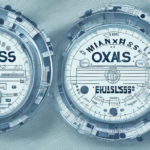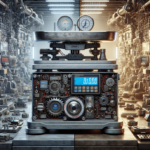CAS RW-L Series vs Ohaus D51XW
When it comes to weighing equipment, accuracy and features are paramount. Two of the most reputable brands in the market are CAS and Ohaus. In this article, we will compare the CAS RW-L Series and Ohaus D51XW to determine which one is better suited for your weighing needs.
Introduction
The CAS RW-L Series and Ohaus D51XW are both highly reliable weighing scales used in a variety of industries, from food service to laboratory applications. While both offer similar features and functionality, there are key differences that set them apart.
The CAS RW-L Series is renowned for its high accuracy and precision, making it a popular choice for laboratory applications where precise measurements are crucial. It also features a user-friendly interface and can store up to 100 different product codes, facilitating easy switching between different weighing tasks.
On the other hand, the Ohaus D51XW is designed with durability in mind, making it an excellent choice for industrial settings where the scale may be subjected to harsh conditions. It boasts a larger weighing capacity than the CAS RW-L Series, making it suitable for weighing larger items. According to Ohaus, the D51XW offers a resolution of up to 10,000 divisions, ensuring highly precise measurements [1].
Overview of CAS RW-L Series and Ohaus D51XW
The CAS RW-L Series is a line of industrial weighing scales that offer a variety of features such as multiple weighing units, counting, checkweighing, and more. They come in different capacities and platform sizes to fit diverse weighing needs.
Conversely, the Ohaus D51XW is an advanced multifunction weighing model designed for use in rugged industrial environments. It offers a wide range of features like statistics, formulation, dynamic weighing, and checkweighing, making it ideal for laboratory, industrial, production, or quality control applications. The Ohaus D51XW is also certified by NTEP and Measurement Canada, ensuring compliance with industry standards [2].
Both the CAS RW-L Series and Ohaus D51XW are known for their durability and accuracy. They are built to withstand harsh industrial environments and provide precise measurements even in challenging conditions. Additionally, both models offer easy-to-use interfaces and intuitive controls, making them accessible to operators of all skill levels. Whether you need a basic weighing scale or a more advanced multifunction model, these two product lines offer a range of options to meet your specific needs.
Features and Specifications of CAS RW-L Series
The CAS RW-L Series comes with a variety of features, including:
- Multiple Weighing Units: Weigh in different units such as kg, lb, oz, and g, providing flexibility in measurement systems.
- Checkweighing Function: Set a target weight range for a batch of items, with alerts if weights fall outside the range, ensuring consistency and quality control.
- Counting Function: Count different objects placed on the platform, ideal for inventory and stocktaking purposes.
- Large LCD Display: A bright, large display makes it easy to read weights from a distance.
- Platform Sizes and Capacities: Available in various platform sizes and capacities to suit specific weighing requirements.
In addition to these features, the CAS RW-L Series includes a built-in rechargeable battery for portable use without the need for a power outlet. The tare function allows weighing items in a container without including the container's weight, particularly useful for measuring ingredients in cooking and baking. The series also features a durable stainless steel platform, ensuring longevity and easy cleaning.
Features and Specifications of Ohaus D51XW
The Ohaus D51XW offers a range of features, including:
- Advanced Weighing Functions: Features applications such as statistics, formulation, dynamic weighing, and checkweighing, ideal for various industrial and laboratory applications.
- Durable Design: Built with a rugged stainless steel platform and indicator to withstand harsh industrial environments.
- Multiple Connectivity Options: Connect to printers, computers, or other devices via USB or RS232.
- Large Display: A large, backlit LCD display ensures readability even in low light conditions.
- Platform Sizes and Capacities: Comes in different platform sizes and capacities to meet specific weighing requirements.
Additionally, the Ohaus D51XW features a user-friendly interface with a simple keypad and dedicated function keys for easy access to different weighing applications and functions. It offers high accuracy and precision with a resolution of up to 10,000 divisions, suitable for weighing both small and large items with reliability.
Comparison of CAS RW-L Series and Ohaus D51XW
When comparing these two scales, it’s important to consider their individual strengths and weaknesses.
Accuracy and Precision
Both the CAS RW-L Series and Ohaus D51XW are highly reliable in terms of precision and accuracy. However, the Ohaus D51XW is known to be more accurate and capable of measuring to a higher degree of precision than the CAS RW-L Series due to its advanced technology and high-quality load cells [3].
Display and Interface
Both scales feature intuitive interfaces with easy-to-navigate menus and keys. The CAS RW-L Series has a large, bright display, while the Ohaus D51XW boasts a larger, backlit display that is easier to read in low light conditions.
Capacity and Platform Size
Both scales are available in different capacity and platform size options. The CAS RW-L Series can accommodate loads ranging from 6kg to 300kg, while the Ohaus D51XW can handle weights up to 300kg, providing greater flexibility for larger items.
Durability and Construction
Both scales are built with durable materials. However, the Ohaus D51XW is recognized as more rugged and long-lasting than the CAS RW-L Series, thanks to its stainless steel construction and IP65 rating, which provides protection against dust and water [4].
Connectivity Options
The Ohaus D51XW offers more connectivity options than the CAS RW-L Series, including connections to printers, computers, and other devices via USB or RS232. In contrast, the CAS RW-L Series only offers USB connectivity, which may limit integration with certain systems.
Price
The CAS RW-L Series is generally less expensive than the Ohaus D51XW, making it a more budget-friendly option for those with financial constraints. The Ohaus D51XW, while more expensive, offers additional features and greater precision, which may justify the higher price for users needing advanced functionalities.
Applications
Both scales are suitable for a wide range of applications. The CAS RW-L Series is particularly well-suited for retail settings, where it can be used to weigh items such as fruits, vegetables, and meats. The Ohaus D51XW, conversely, excels in laboratory and industrial settings where precision and accuracy are paramount.
User Reviews and Feedback
Users of both scales generally agree on their high accuracy and reliability. However, some users have reported issues with the connectivity of the CAS RW-L Series, while others have noted that the Ohaus D51XW can be challenging to set up and use initially. Nonetheless, both scales have received high ratings and are regarded as some of the best in the market.
A common feature appreciated by users of both scales is their durability. Many have reported that both the CAS RW-L Series and the Ohaus D51XW are built to last and can withstand heavy usage without issues. Additionally, both scales come with useful features such as the tare function, counting mode, and multiple weighing units, making them versatile and suitable for a wide range of applications.
However, some users have noted that the CAS RW-L Series can be a bit noisy during use, which can be a concern in quiet environments. On the other hand, the Ohaus D51XW has been praised for its user-friendly interface and intuitive controls, making it easy to operate even for those unfamiliar with weighing scales.
Pros and Cons of CAS RW-L Series
Pros
- Multiple weighing units for flexibility.
- Checkweighing function ensures quality control.
- Counting function ideal for inventory management.
- Large, bright display for easy readability.
- Various platform sizes and capacities to fit different requirements.
- More affordable than the Ohaus D51XW.
Cons
- Only offers USB connectivity.
- Connectivity options can be problematic according to some users.
- Not as durable as the Ohaus D51XW.
Additional Information
One of the advantages of the CAS RW-L Series is its user-friendly interface. The buttons are easy to navigate, and the display is clear and concise, allowing users to operate the scale without confusion or frustration.
Another benefit is its compact design. It occupies minimal space, making it ideal for small workspaces. Additionally, it is lightweight and easy to move around, which is useful for those needing to transport the scale to different locations.
Pros and Cons of Ohaus D51XW
Pros
- Advanced weighing functions for diverse applications.
- Large, backlit display ensures readability in various lighting conditions.
- Durable and rugged design suitable for harsh environments.
- Multiple connectivity options for enhanced integration.
- More accurate and precise than the CAS RW-L Series.
Cons
- More expensive than the CAS RW-L Series.
- Can be difficult to set up and use initially according to some users.
Despite the higher price point, the Ohaus D51XW is a popular choice among professionals in various industries due to its advanced features and durability. It also offers a wider range of connectivity options, making it easier to integrate into existing systems. However, some users have reported difficulties with the initial setup and operation of the scale, which may require additional training or support.
Conclusion: Which One to Choose?
The choice between the CAS RW-L Series and Ohaus D51XW ultimately depends on your specific weighing needs and budget. If you are looking for a reliable and budget-friendly option, the CAS RW-L Series might be the better choice for you. However, if you need a highly durable and precise scale with advanced weighing functions and connectivity options, the Ohaus D51XW is an excellent investment.
It is important to consider the environment in which the scale will be used. If you are working in a harsh or wet environment, the Ohaus D51XW's stainless steel construction and IP65 rating make it a better choice. On the other hand, if you are working in a dry environment, the CAS RW-L Series' plastic construction may be sufficient. Additionally, if you require legal-for-trade certification, the Ohaus D51XW is certified by NTEP and Measurement Canada, while the CAS RW-L Series is only certified by NTEP [5].
Final Thoughts on CAS RW-L Series vs Ohaus D51XW
Both the CAS RW-L Series and Ohaus D51XW are excellent weighing scales that offer a variety of features and options to meet different weighing needs. Ultimately, the choice comes down to the specific requirements of your industry and application. Consider factors such as accuracy, durability, connectivity, and budget to make an informed decision that best suits your operational needs.






















